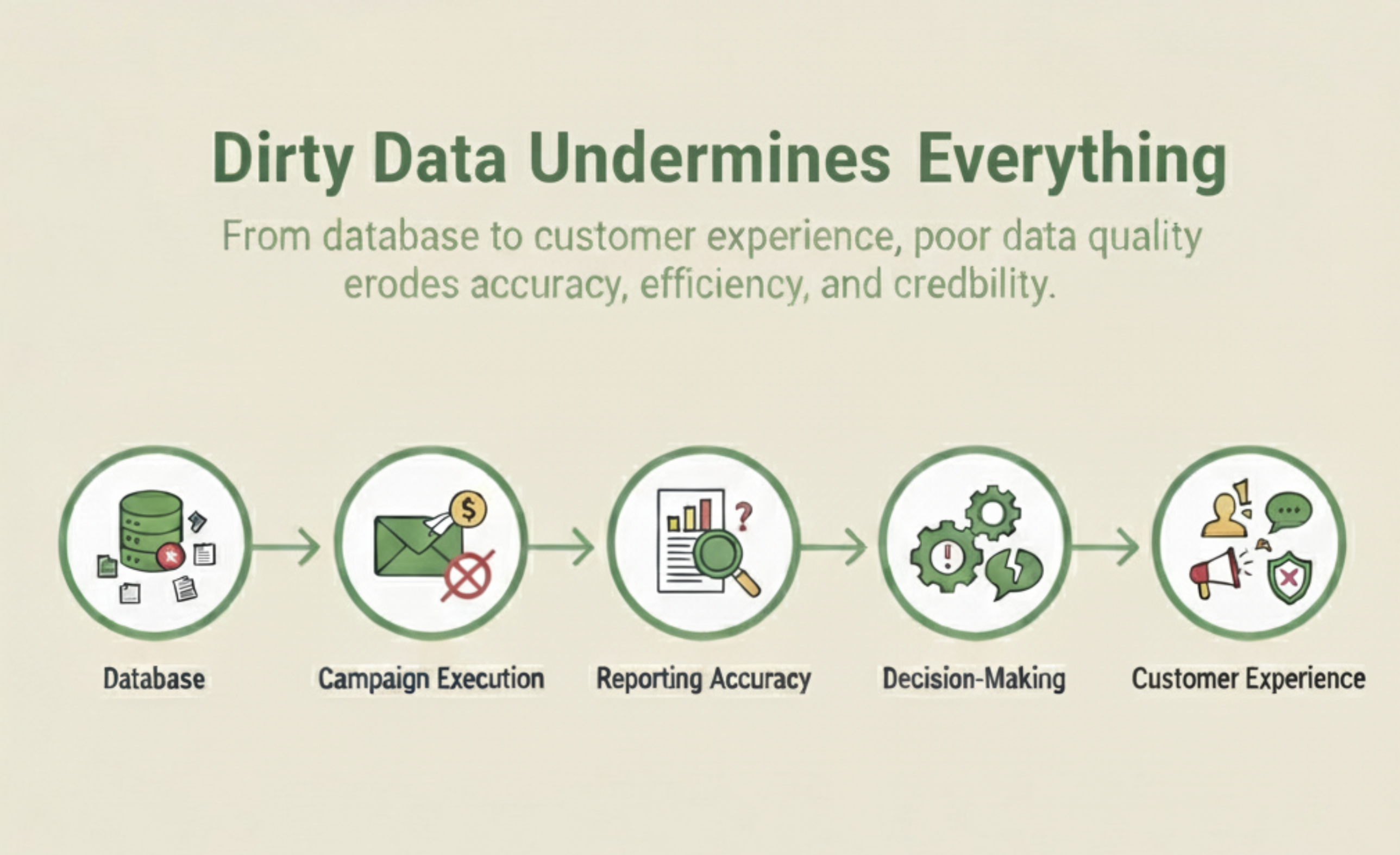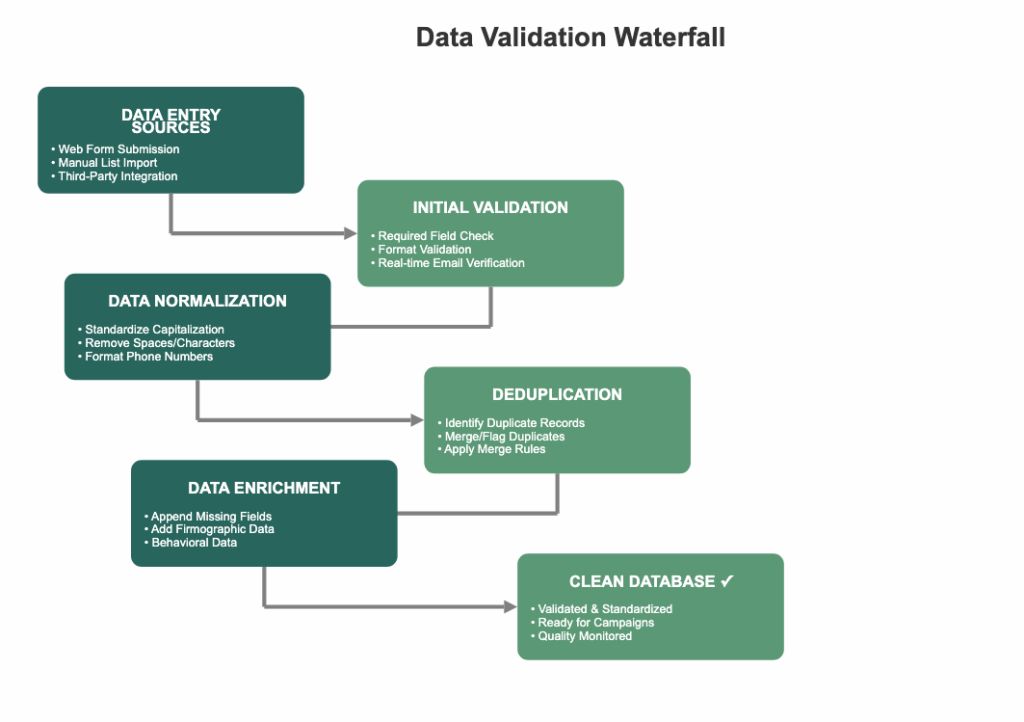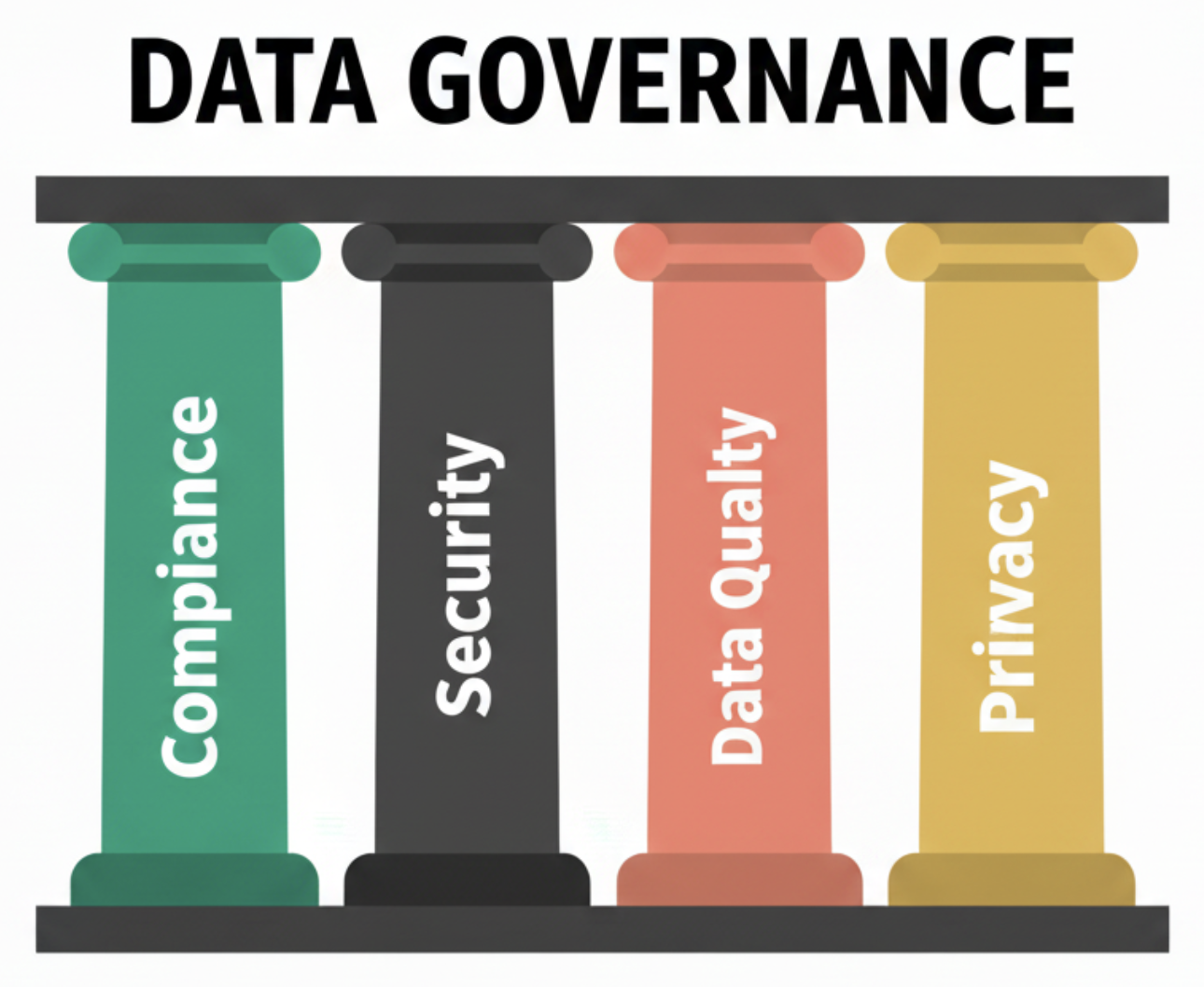Overview
The success of any marketing strategy—from personalized email campaigns to accurate lead attribution—rests on a single, critical foundation: your database. For us in marketing operations, a dirty database isn’t just an inconvenience; it’s a major problem. It leads to inaccurate reporting, poor audience segmentation, wasted ad spend, and, most importantly, a fragmented customer experience.
Your database (be it your Marketing Automation Platform or CRM) is your most valuable asset. The quality of your data directly impacts the quality of your results. This guide will walk you through the essential components of database hygiene, providing a practical roadmap to turn your data from a messy liability into a clean, strategic asset.
Understanding the “Why”: The Critical Importance of Database Cleanup
Why does a clean database matter so much? Simply put, bad data compromises everything. It’s the silent killer of marketing efforts, and the consequences are felt across the business. Gartner estimates that poor data quality can cost large businesses an average of $12.9 million annually in wasted resources and lost revenue. When dirty data fills your database, marketing campaigns miss the mark, sales teams misread prospect needs, and opportunities slip through customer service teams unnoticed. Consequently, brand credibility and morale erode, teams lose time chasing down unqualified leads, and revenue growth stalls.
Depending on the tech stack, poor data quickly can spread across systems, multiplying errors and compounding the cleanup. If left unchecked, the problem only grows harder and more time-consuming to resolve. Simply put: without clean data, efficiency, accuracy, and credibility all collapse.
- Inaccurate Reporting: Reporting metrics drawn from misleading and unreliable datasets makes it impossible to properly conclude whether your marketing strategy is truly working. This inconsistency in your data will result in incorrect assumptions that will negatively influence your ability to make informed and accurate business decisions.
- Poor Personalization & Segmentation: Without clean, reliable data for segmentation, your ability to craft relevant and personalized messaging that resonates with the right audience at the right time is severely limited. This leaves you with generic and imprecise campaigns that restrict your level of engagement.
- Impact on AI & Predictive Models: With more businesses implementing AI models into their workflows, it’s vital to remember that the effectiveness of these tools depends entirely on the quality of the data they’re fed. If a model ingests inaccurate or compromised data, you risk automating mistakes at a massive scale. The cost of this is a loss of millions in revenue and credibility. In 2022, Unity Technologies reported a loss of $110 million after ingesting bad data into its machine learning algorithm. Clean data isn’t just helpful for AI; it’s the absolute prerequisite for building models that are reliable, trustworthy, and actually capable of driving business growth.
- Wasted Ad Spend: A messy database will result in inefficient and costly campaigns that lead to wasted resources and missed opportunities. There is greater potential to target the same people multiple times, send emails to inactive addresses, or suppress the wrong contacts, all of which will erode your budget and ROI.
- Compliance Risks: In the age of GDPR, CCPA, and other data privacy regulations, failing to maintain a clean database can increase the risk of your organization facing serious financial and legal risk.
A clean database isn’t a “nice-to-have”; it’s the operational bedrock of a data-driven marketing team.

Key Elements of a Database Cleanup Strategy
Database hygiene is an ongoing practice, not just a one-time event. A comprehensive strategy should include these core components:
- Data Validation: This is typically your first line of defense against bad data. An important part of database hygiene is not just cleaning what’s already in your system, but closing off the sources where errors enter in the first place. Once you identify where most of your bad data sources come from (e.g., manual list uploads from sales, unvalidated web form fields, poorly mapped integrations with third-party tools), you can implement strategies to tighten those entry points. You can enforce field requirements (e.g., no record without a company name), apply validation to ensure data is captured in the specified format, or use dropdowns and radiolists to reduce freetext. Beyond this, normalizing the data ensures every record maintains the same standards as it enters your system, keeping everything consistent and clean across all platforms.
- De-duplication: Duplicate records are a common issue that inflates contact counts and skews your data. Tools and processes should be in place to identify and merge or remove these redundancies.
- Data Enrichment: Missing data fields can limit the utility of a data set. While you should aim to collect essential information upfront, leveraging third-party data enrichment tools to fill in the gaps can add valuable demographic, firmographic, and behavioral data to your records, enhancing your ability to segment your audience.
- Inactive Data Management: Regular purges of inactive, bounced, or unsubscribed contacts are crucial for maintaining good sender reputation and compliance. Don’t be afraid to remove contacts who haven’t engaged in a long time—they’re often more of a liability than an asset.
- Data Standardization: Establish and enforce a standardized process and consistent format for all data fields. This includes everything from how job titles are written to the capitalization of state names. This is especially critical for reporting and segmentation.

Establishing a Process and a Roadmap to Clean Data
Instead of a massive, overwhelming one-time project, approaching database hygiene as a continuous process with a clear cadence is paramount for maintaining health and consistency.
- Ongoing (Real-Time): Your best defense against unhealthy data is to identify it at the source. This means implementing required fields and validation on all your forms to ensure key information is always captured and common errors like incorrect formats or typos are corrected and standardized before flowing into your database.
- Weekly: Week over week, you can leverage automation to free up your time to routinely monitor some of the more frequent occurrences you want eyes on. That may entail building out dashboards and reports that provide at-a-glance insights on your data’s health, flagging potential issues as they arise (e.g., a sudden increase in new contacts or an abnormal spike in bounce rates). Additionally, you can set up workflows in your MAP or CRM to automatically check for and merge duplicate records and normalize field formats. To stay ahead of larger problems, you can also set up system alerts that notify you of failed integration syncs or when the number of contacts without a required field exceeds a certain number.
- Monthly: Once a month, schedule time to address those small inconsistencies you’ve noticed popping up week over week from the source. This is also the time to review the data coming in from any new forms or integrations to make sure everything is populating and functioning correctly.
- Quarterly: Four times a year, you should conduct a more thorough data audit where you identify and remove or suppress inactive contacts, and review your database for any larger, emerging data quality issues that may impact your marketing efforts down the line.
- Annually: Once a year during your annual review, performing a comprehensive database review will help to assess whether your data is still aligned with and serving your strategic business goals. This looks like archiving old records, evaluating historical database trends, revisiting data governance policies, etc.

The Role of Data Governance
Fortunately for you, database hygiene is a team sport that requires a clear data governance policy that outlines key players who are responsible for managing and enforcing data quality standards across the business.

This policy should outline:
- Roles and Responsibilities: It is essential to clearly define who owns the data. A Data Steward is the individual, team, or cross-functional group (marketing ops, sales ops, legal/privacy) responsible for managing an organization’s data set and maintaining its quality and accuracy, while ensuring compliance with data governance policies. Other considerations within this bucket should include clearly defining system owners/administrators. These core roles have the power to make changes, create new fields, and are tasked with the burden and ownership of preventing data chaos.
- Data Standards: Establishing and documenting standards for your data entry is necessary to ensure that every team agrees and is following the same rules, from sales to marketing. This is where a data dictionary becomes pivotal for the team. A data dictionary is a centralized repository that outlines the context, definition, and properties of the data used across the organization, serving as a single source of truth to ensure consistent understanding, usage, and governance for multiple teams. This piece is fundamental for helping teams deal with cross-system issues and enhance data literacy by preventing the kind of data inconsistencies that can arise from siloed departments.
- Automation & Tools: While the data dictionary provides the playbook, automation is how you ensure policies are being followed and are consistently applied across the business. Rather than expecting team members to remember the rules, you can embed data standards directly into your systems using automated workflows to normalize values, validate emails, and enrich records with missing details. This transforms your governance from policies and documents to a framework that enforces quality and reduces the risk of human error.
Your Database Cleanup Roadmap
This simple, actionable roadmap will help you get your feet off the ground, build momentum, and keep it going over the long haul:
- Assess Your Current State: Start with an audit. How many contacts do you have? What’s your bounce rate? Identify the areas of greatest need.
- Define Your Standards: Before you begin cleaning, get your team to agree on a single, standardized way of formatting data. Document everything.
- Clean Up: Start with the basics. Run a de-duplication project and standardize your most critical data fields.
- Implement Automation: Set up automated workflows for data validation and normalization. This prevents new bad data from getting in and saves you from having to do it all manually again in the future.
- Establish a Cadence: Schedule the weekly, monthly, quarterly, and annual tasks we outlined above.
- Monitor & Optimize: Regularly review the health of your database and adjust your processes as your business needs evolve.
Conclusion
A clean, well-managed database is the engine of a high-performing marketing organization. By treating database hygiene as a strategic priority, you’re not just cleaning up data—you’re building the foundation for more effective campaigns, more accurate insights, and ultimately, better business results.







